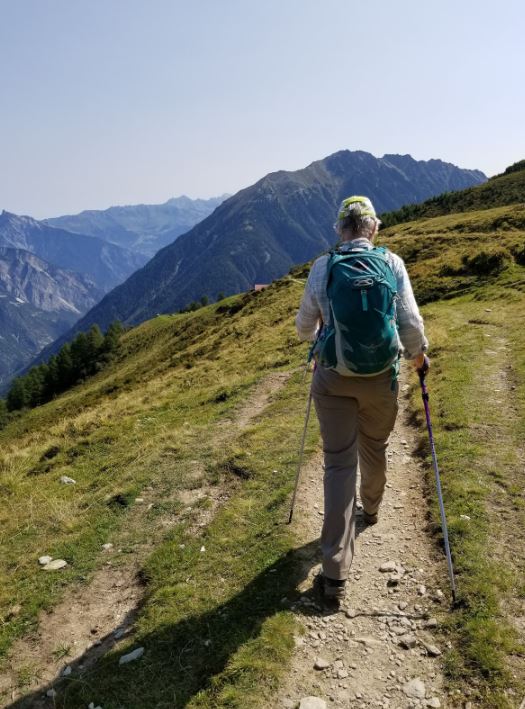Let’s talk terrain
Many people wonder if the Haute Route is going to be too difficult. I’m not going to lie, it is a physically and mentally draining trek through rigorous terrain. However, if you are up to the challenge and come prepared, it is one of the most rewarding treks you will ever go on. As I explain the Haute Route terrain conditions more thoroughly, consider whether you will be able to participate in this rigorous and strenuous trek.
The Haute Route has many different types of terrain. We recommend our guests be in excellent shape and expert trekkers in order to handle all of the challenges this route presents.
Paved roads
There are a few parts of the Haute Route terrain that are paved, don’t expect it very often so enjoy it while it lasts! The times you do have it, it’s a welcomed break from the rocky terrain of the regular trail.

Dirt Trails
The Haute Route is full of dirt trails, it is not uncommon to come across roots, rocks and other obstacles as you hike. For this reason, we recommend you wear ankle boots, which are designed for terrain such as this. The extra support around your ankles can help prevent sprains. On an ideal weather day, these trails can still be tricky, which is why you should be prepared for some mud when it rains. You will want to make sure you have rain gear, this way even if you have spotty weather you will be able to hike with confidence.

Rocky paths
As mentioned above, there are lots of rocks on the trail. You’ll want to make sure you watch your step so you don’t trip. The Haute Route is a trek that you want to have sure footing. For this reason, when you are training for the trek, we recommend doing hikes with similar conditions. Your trekking poles (we recommend these for all of our treks and hiking tours), are ideal support if you are prone to tripping or sliding on little rocks.

Boulder fields
There are quite a few boulder fields on both the Chamonix to Zermatt Haute Route as well as the Deluxe Haute Route. We do not recommend using trekking poles for these parts. Poles can get stuck in rocks and distract you. Also, it is much easier to steady yourself with your hands in these fields. As you use one hand to steady yourself as you climb over the rocks, it can seem a little scary at first, but as you take your time crossing the field, and you should not have problems. If conditions are wet, take extra caution in crossing boulder fields as it is easy to slip and such a fall on uneven footing can be dangerous.

Snow crossings
Snow crossings are uncommon but are present depending on the weather. If you do find yourself at a snow crossing, it can be about 30 – 40 feet long (~9 meters). On the Chamonix to Zermatt Haute Route there are many high elevations at the mountain passes, these are the places you may see snow. Rest assured, that you will not need any special gear such as crampons or ice axes for these crossings. They are easy to cross and you will be just fine with the help of your trekking poles, and guide. That being said, proceed with caution.

River Crossings
Many people wonder if there are river and stream crossings on the Haute Route. The answer is yes, you will cross some rivers and streams on the route. Hazards include loose, wet rocks that can result in uneven footing. All rivers and streams either have bridges or other rock crossings. The crossing widths and depths are small enough that you can walk through in your normal hiking boots. No additional water-crossing gear will be necessary.
I hope this Haute Route terrain post has been informational in helping you decide if you an expert hiker and prepared for the challenge of the Haute Route. Remember that the trek is incredibly wonderful and rewarding for those who are well-prepared. The Chamonix to Zermatt Haute Route includes remote huts and excludes a rest day. The Deluxe Haute Route skips the huts and includes a rest day. We encourage you to pick your fancy.
See you on the trail!

- Alpine Trail Markers - November 26, 2020
- Why You Should Have Trekking Poles and How to Use Them - November 12, 2020
- The Alps’ Haute Route: A Brief History - September 3, 2020



Hi Jamie, I’m looking to do the Haute Route on my own this July – sleeping in a tent for the most part. I don’t have any hiking experience but I am physically very fit, although mostly from gym classes and running. My main concern is navigation. Would you have any advice for me?
Best regards, Brian
Hi Brian, Congratulations! The Haute Route will be the trip of a lifetime. Swiss trails are well marked in general. However, navigation can become difficult in the boulder fields, especially. We always recommend having ways to communicate with people in the case of an emergency. At Alpenwild, we do offer a self-guided Haute Route itinerary that will give you step by step Haute Route instructions. Here’s the link to purchase the self-guided tour if it is of interest to you: https://www.alpenwild.com/trip/self-guided-haute-route/overview/. Happy travels!